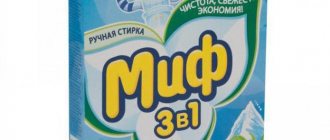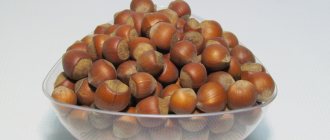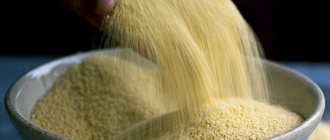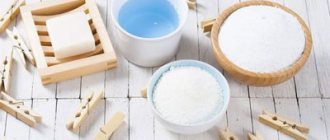When choosing a laundry detergent, few people think about the shelf life of the product. First of all, pay attention to the composition and cost of the washing powder. And this is a fundamentally wrong position.
The thing is that the chemical elements that make up the detergent are effective only for a certain period of time (subject to storage rules).
Expired powder is not only useless for quality washing, but also dangerous to human health. We’ll talk about the shelf life of washing powder in the article.
How long is it stored?
The idea that washing powder can be stored indefinitely is a myth. In fact, the activity of the chemical components responsible for the effective removal of stains from fabric remains for a certain period of time (an average of three to five years).
The storage period is indicated by the manufacturer on the product packaging (depending on the components of the detergent). So in hermetically sealed packaging, subject to storage conditions:
regular washing powder is suitable for use for five years (after opening the package no more than twelve months);- Bio products, which contain components of natural origin, are effective for three years from the date of release (after opening the package no more than six months);
- detergents for washing children's clothes, which contain biologically active components (enzymes), retain their positive qualities for a minimum amount of time - only two years (after opening the package no more than six months).
If the packaging does not indicate an expiration date, then it is better to refuse such a purchase. The absence of shelf life markings violates the requirements of current legislation and, most likely, such a product will not meet quality and safety requirements.
Topic No. 6. Powders with extracts
The cooking technique is determined by their consistency. Dry (1:2), thick and dry extract solution (1:2) is used.
Example No. 1
Powders with dry extracts are prepared according to the general rules for preparing powders.
Rp.: Extracti Belladonnae 0.015 Bismuthi subnitratis 0.2 Magnesii oxydi 0.25 Mf pulvis Dtd No. 10 S. 1 powder 3 times a day after meals
Belladonna extract is a list B drug, let’s check the doses.
Reverse side of the PPK:
M (demandalis) = 0.015*10 = 0.15 M (bismuth) = 0.2*10=2 M(magnesium) = 0.25*10=2.5 M(total) = 0.15+2+2 .5=4.65 g р1 = 4.65/10=0.465
Because If the extract is prescribed as dry, then in the calculations we take into account that it is 1:2, so we increase the mass of belladonna extract by 2 times. As a result, the weight increases.
M (extract) = 0.15*2 = 0.3 g M (total) = 0.3+2+2.5=4.8 p1 = 4.8/10=0.48
Technology:
In a mortar, carefully grind 2 grams of bismuth subnitrate, pour it onto the capsule, leaving about 0.3 g. Add 0.3 g of belladonna extract, grind, add bismuth in several steps while stirring, at the end add magnesium oxide, mix. Dispense 0.48 g into waxed capsules.
Example No. 2
When using a thick extract: weigh out on a mug of filter paper and transfer to the head of the pestle. To separate the paper from the pestle head, moisten it with a few drops of 20% alcohol.
Then the extract is ground with a pestle and mortar with a few drops of 20% alcohol, after which the dry ingredients are added. To make work easier, pharmacies prepare solutions of a thick extract (1:2).
100 g of thick extract is dissolved in a mixture of 60 g of water, 10 g of 90% alcohol and 30 g of glycerin. Store for no more than 15 days. The main property is flowability.
Bismuth subnitrate was ground, a belladonna solution was added, then magnesium oxide.
Example No. 3
Powders with a solution of dry extract.
Rp.: Extracti Belladonnae 0.015 Papaverini hydrochloridi 0.02 Sacchari 0.3 Mf pulvis Dtd No. 10 S. 1 powder 3 times a day after meals
Dose check:
Papaverine h/x VSD - 0.2 LSD - 0.02 VSD - 0.6 LSD - 0.06
Belladonna extract
VSD - 0.05 LSD - 0.015 VSD - 0.15 LSD - 0.04 Doses are not excessive
Reverse side of the PPK:
M (extract) = 0.015*10 = 0.15 g M (papaverine) = 0.02*10 = 0.2 g Mfree. (glucose) = 0.3*10= 3 g
A 1:2 solution of dry extract is prepared from the thick extract by dissolving it in a mixture of 6 parts water, 3 parts glycerin and 1 part ethyl alcohol 96%.
M (extract) = 0.15*2=0.3 g M (total) = 0.3+0.2+3=3.5 g p1 = 3.5/10 = 0.35 g
Technology: first add sugar (to mash the walls), then papaverine hydrochloride, then sugar again, at the very end belladonna extract drop by drop.
How to properly organize storage conditions?
to maintain the effectiveness of washing powder throughout the entire period of its use only if certain storage rules are followed:
- Packages with washing powder are stored away from heating appliances. The thing is that high temperature accelerates chemical processes in granules, thereby reducing the shelf life of household chemicals. For the same reason, it is necessary to ensure that the powder is not exposed to direct sunlight.
- The optimal air temperature in the room where laundry detergent is stored varies from +15°C to +25°C.
- Detergents are stored in a dry, well-ventilated area. High humidity is the first enemy of dry washing powder. When wet, the granules clump into dense clumps, which are not only ineffective in combating stains on clothes, but can also negatively affect the operation of the washing machine’s mechanisms. The air humidity in the room in which the detergent is stored should not exceed 60%.
- When choosing a storage location, it is very important to remember that all laundry products are primarily chemicals. This means that washing powder is stored out of the reach of children and pets, away from food and personal care products, toys, dishes and other household items. The slightest ingress of washing powder particles into the body can provoke severe poisoning.
Topic No. 2. Complex powders
May include drugs with different physical and chemical properties. The quantitative ratios of ingredients in complex powders often vary widely.
NB!!!!! The medicinal substances of the complex powder are prescribed in equal or approximately equal quantities (the ratio in mass does not exceed 1:5).
In this case, two mixing options are possible.
- If the physicochemical properties of medicinal substances are approximately the same, then they are mixed taking into account the amount of loss when grinding in a mortar
2. If the physicochemical properties of medicinal substances are different, then mixing and grinding begin with a coarse-crystalline substance, and then fine-crystalline substances are added to it.
NB!!!!! Medicinal substances of the complex powder are prescribed in various quantities (mass ratio more than 1:5).
In this case, the procedure for preparing the powder is as follows:
- The drug that is included in larger quantities and has less loss in the pores of the mortar is crushed first.
- Then the crushed powder is poured onto the capsule, leaving a small amount in the mortar (about as much as the next ingredient).
- Mixing begins with the ingredient prescribed in the smallest quantity, gradually adding the remaining substances in increasing order of the prescribed quantities, taking into account the crystalline structure and atomization of the medicinal substances.
NB!!!!! Grinding should begin with the substance whose loss in the mortar pores is the smallest.
NB!!!!! If the recipe does not contain an auxiliary substance (sugar), grinding should begin with the substance that is prescribed in the largest quantity and is least lost in the pores of the mortar.
NB!!!! Medicinal substances such as zinc oxide, magnesium oxide, acetylsalicylic acid, magnesium carbonate and others, when ground, stick tightly to the walls of the mortar and are compressed, so it is recommended to grind them carefully, without much effort.
NB!!!!! Amorphous substances ( talc, magnesium oxide, starch, etc.) are mixed with the powder mass without additional grinding.
NB!!!!! Lightweight substances (sprayable) are added to the mixture last to avoid losses. (magnesium oxide, magnesium nitrite, starch, talc, calcium nitrate).
Example #1:
Rp.: Bismuthi subnitratis Magnesii oxydi aa 0.25 Misce fiat pulvis Dtd No. 12 Signa: 1 powder 3 times a day
Reverse side of the PPK:
Bismuth subnitrate 0.25*12 = 3 g Magnesium oxide 0.25*12 = 3 g
Total mass (m) = 3+3 = 6g Mass of one powder (p1) = 6/12 = 0.5
Front side of the PPK:
Bismuthi subnitras 3.0 Magnesii oxydum 3.0 __________________________ m = 6.0 p1 = 0.5 No. 12
Prepared: Packaged: Checked:
Technology: I weigh out 3 grams of bismuth subnitrate on a hand scale, thoroughly grind it in a mortar, and then add 3 grams of magnesium oxide while stirring in several steps. Check for homogeneity. We weigh 0.5 g into waxed capsules.
Label:
Example #2:
Rp.: Dibazoli 0.01 Sachari 0.2 Mf pulvis Dtd No. 10 S. 1 powder 2 times a day
If the drug is on list B for children, then we check the doses
Reverse side of the PPK:
Dibazol 0.01*10 = 0.1 g Glucose 0.2*10 = 2 g
Total mass (m) = 2+0.1 = 2.1 g Mass of one powder (p1) = 2.1/10 = 0.21 g
Front side of the PPK:
Sacchari 2.0 Dibazol 0.1 __________________________ m = 2.1 p1 = 0.21 No. 10
Prepared: Packaged: Checked:
Technology: Preparatory operations are carried out in accordance with Order No. 309. Check drug doses. Powders are prescribed in a quantitative ratio of 1:20. Weigh out 2 grams of glucose on a hand scale, thoroughly grind it in a mortar, pour it onto the capsule, leaving about 0.1 gram. Weigh out 0.1 grams of dibazole and pour it into a mortar and grind. Grind, mix, add crushed sugar in several additions, mix again. Check for homogeneity. Dispense 0.21 g into waxed capsules.
Label:
If it's expired, can it be washed?
The main question that any housewife asks: “What to do if the expiration date has expired and the product has not been fully used?”
Definitely, you should not wash with such a powder . It is no longer possible to achieve ideal cleanliness and freshness of laundry and remove all stains by washing with an expired product.
Also, do not forget that dense, clumped granules that have changed the smell are very difficult to wash out of the fabric fibers. Contacting human skin through clothing, they can cause severe irritation and redness, and when inhaled, accumulating in the lungs, triggering an asthma attack in allergy sufferers.
It is especially dangerous to use expired powder to wash the clothes of young children, whose immune system is sensitive to contact with harmful chemicals.
Bleach must be replaced if it is not used after six months.
Most furniture polishes have a service life of up to two years.
Hydrogen peroxide, if left unopened, should keep for about a year; if opened, should be used within 60-90 days.
Shelf life shouldn't matter for microfiber products, but how long they last depends on care. As long as a product's microfibers are not exposed to softeners or detergents that contain them, and high-temperature drying is avoided, they can last over 100 washes. “However, if they start to darken or become discolored, you will likely have to dispose of them.”
Adviсe
A few tips from experienced housewives will help preserve the beneficial properties of washing powder longer:
When purchasing a large amount of powder in various packages, you should not open all the packages and boxes at once. In closed packaging, the detergent retains its beneficial properties longer.- A clothespin, which is used to clamp the hole on an already opened package, will help protect the powder from moisture.
- Buying a special container for household chemicals will help solve the problem of storing detergents.
A plastic container with a tight-fitting lid will protect the dry powder from moisture. A special locking mechanism prevents small children from opening the container freely, and the especially durable, colored plastic from which the container is made will protect the product from direct sunlight. A convenient recess at the end of the container and a measuring cup in the set will help you carefully pour the powder into the washing machine.
Strict adherence to the storage recommendations specified by the manufacturer on the packaging will protect the washing powder from premature deterioration.
Find all the most useful and interesting things about washing powder in this section of the site.
What to store in
The ideal solution would be to pour the product into a special container. A household plastic container is perfect, here are its advantages:
- If the lid closes tightly and is additionally secured with latches, the risk of spillage is minimal. Children or pets will not open such a box.
- The polyethylene or polypropylene from which the containers are made does not allow moisture and sunlight to pass through. Therefore, you can store it directly in the bathroom.
- Manufacturers specially make volumetric containers of 5-10 liters narrow to simplify placement in small spaces.
- Ergonomics: carrying handles, convenient recesses, spouts for filling, measuring cups. All this and much more simplifies the operation of the container.
- Price and availability. You can find a container in almost any hardware store by choosing the appropriate color, volume, size and shape.
Now you know the rules that will not only protect you from the chemical effects of detergents, but will also help extend their shelf life and compactly place them in a suitable room.
Perox
A universal cleaning product that can also be used for laundry is bleach, but it does not contain chlorine. This product copes well with all types of dirt and stains, and to add fragrance to the laundry, you can drop a couple of drops of any synthetic fragrance into the drum. For one wash cycle you will need about 100-150 ml of product.
As you can see, you can often do without powder, but provided that you choose the right replacement, even if it’s temporary.
AlinaAuthor of the article
Did you like the article?
Share with your friends:
Marking
The product data list includes the following:
- Name;
- what method: automatic, manual, station wagon;
- types of fabrics;
- machines: professional, automatic, activator type;
- amount of ingredient by type of wash;
- compound;
- normative and technical act;
- manufacturer (country, address, company);
- warning notices;
- weight or volume of a substance;
- storage conditions;
- disposal method;
- shelf life, date of manufacture, expiration date;
- how long can it be stored?
- barcode;
- dangerous moments of use, how to avoid them;
- Can it be used after the expiration date?
ATTENTION: the text and pictures on the packaging must be well and clearly printed, this protects against counterfeiting.
Residual effect?
Surfactants remaining in fabrics after washing can be dangerous to people. To evaluate this indicator, the surfactant content is checked not in the fabrics themselves, but in the water remaining after washing and the third rinse. The logic of this test is as follows: if after repeated rinsing surfactants still continue to be washed out of clothes and linen, then they are in the fabrics, and the more surfactants are in the water, the more of them there were in the fabric. The maximum amount of anionic surfactants remained in the water (and therefore in the laundry) after washing with Ariel powder. Least of all - after Dosia powder.
How to wash a down jacket and get rid of scale? 6 myths about washing machines
We recommend: How to properly wash fleece











